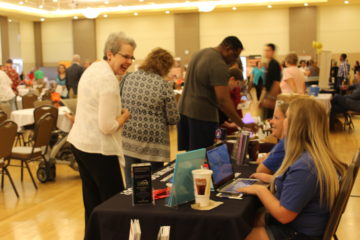By DAVID DUPONT
BG Independent News
In my many years of covering speeches, I have never jumped up onto the speaker’s back.
But in his Optimal Aging Community Fair keynote address Colin Milner, the CEO of the International Council on Active Aging, said we must continue to try new things even as we get older.
So when asked for a volunteer – a male volunteer from a crowd that was predominantly female, I raised my hand. The woman sitting next to me made sure he saw it.
Milner brought me on stage in Bowling Green State University’s Grand Ballroom. After a few tries – I’m 62 and not as agile as I once was – I bounded awkwardly onto his back. And with my stocky frame astride his stocky frame, he started asking the audience questions.
How easy with me on his back would it be for him to climb stairs? Or play with his grandchildren? Would he be able to catch himself if started to fall?
“This is what being inactive looks like,” he said. “Taking David off is what being active looks like. Keeping our strength as we get older, keeping our power, keeping our agility, so that at the end of our life … we compress morbidity so that actually are spending as much of our life in optimal health as possible.”
Milner said: “Between the ages 35-70, we begin to lose our function. … If we are inactive it continues to decline throughout our life. But if we remain active, we can reduce that loss of function significantly.”
During that period we lose 50 percent of our strength. “That’s one of the reasons we decline.”
So having me on his back was to simulate that loss of strength, or maybe it’s just his way of exercising.

Attendees peruse displays at BGSU Optimal Aging Community Fair.
Aging goes beyond the physical. The international expert who has said he wants to change the face of aging, explained how people need to stay mentally active and socially active, and how all these factors interconnect.
He showed images of an outdoor exercise session in Japan where people stay around to socialize after they’ve completed their tai chi. He touted a new, upscale looking retirement community that’s hosting camps and activities for children. He showed a video of a wizened, wiry gent scaling an ancient ruin. He flashed a slide of a man who ran marathons at 100, and another of a man who took up hockey at 90.
“Our goal is to keep our level of function up as high as possible,” Milner said. But “physical inactivity is a global pandemic.” But it’s hard to get through to some people.
Milner speaks all over the world about this, but his own father won’t listen to him. His father has slipped into inactivity, sitting in a chair watching television and reading and sending his son emails about dangerous places he should not venture. He can barely walk a block without needing to sit.
This can be reversed, Milner said.
He noted that how one maintains and reverses strength, power and flexibility varies by the individual. “No two individuals age exactly the same way,” he said. “This is something we need to seek, not something that is prescribed.”
That goes for cognitive ability and sociability as much as health.
Attitude and outlook play a large part. “Just thinking negatively about aging will reduce life span by 7.6 years,” Milner said. That’s as much as smoking or obesity. “Thinking positively has a huge impact on how we actually age.”
“You’re alive,” he said. “It’s a great thing to grow older. Embrace it.”
And never let anyone say someone is too old for something. “I should be able to do what I wish to do.”
This concern about wellness comes at a time when “people are living with diseases that used to kill them,” he said. “We’re now living with diabetes, high blood pressure, heart disease. … We are managing health better than we used to.”
The goal now is to make those additional years as good as possible. That means maintaining strength, power and agility. “The challenge is we don’t just do it. We believe it, but we’re not doing it.”
Toward the end, he asked: “What would your life be like if you embraced your potential? No one can do that but you.”
That’s rub. This is personal. At every turn, I weighed Milner’s advice, his cajoling, encouragement on a very personal scale.
People launching new businesses later in life. Did that, and that takes a chunk out of the time to exercise.
Try something new? I want more time to do those things I already love that always seem to get set aside.
This doesn’t even touch the issues of finances, family and housing.
Getting old is not for the retiring type. Getting old with grace and strength is a full-time job. If fact, we may need to work overtime to do it.
That’s why the Optimal Aging Institute is so valuable. It promises by engaging the community to help people find their own path to vitality, balancing life’s many demands and promises. There’s no one way to age, but there’s no good way to avoid it.

